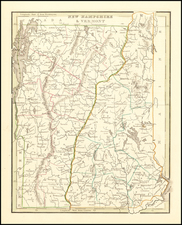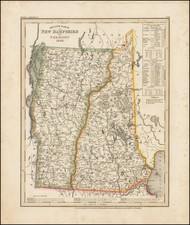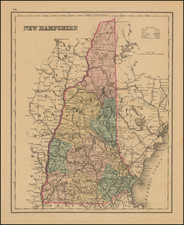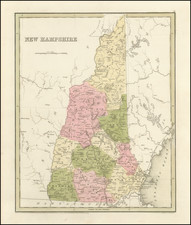Memorialized by Thoreau & Emerson -- Home of the Dublin Art Colony
Finely crafted map of Dublin and the the south part of Harrisville, depicting in meticulous detail the lakes, ponds, reservoirs, roads and numerous man made features, with and elegant topographical imagry of the neighboring mountains and hills.
Dublin and its environs were first memorialized by Ralph Waldo Emerson and Henry David Thoreau, who wrote abut Mount Mondanock, which appears at the bottom of the map. Ultimately, it would become a home to the Dublin Art Colony.
The map's origins trace back to a survey conducted by Thomas Fisk in 1853. More than half a century later, Samuel Wadsworth revisited the map in 1906, making valuable additions and corrections and printed by C.J. Peters & Son Co. in Boston.
The map is centered on Monadnock Lake and Dublin Village, the heartbeat of the town. The reference key further deepens our understanding of the town's intricate layout:
- Present Highways
- Former Highways or roads but little used
- Private roads or Avenues
- Paths or trails
- Present Buildings
- Sites of Former Buildings
- Roman numerals, Range numbers
- Arabic do. Lot numbers
- Small numbers refer to Printed Index
- Elevations and some other details from the map of U.S. G. Survey
The Dublin Art Colony emerged as a vibrant hub of artistic expression, largely due to its magnetic draw from the natural beauty of the surroundings and its appeal to the intelligentsia of the era. Dublin's unique blend of tranquility, intellectual stimulation, and natural allure made it a gathering place for some of the finest talents of the late 19th and early 20th centuries. Here's a detailed history:
Abbott Handerson Thayer (1849-1921): The pioneer of the Dublin Art Colony, Thayer's influence in Dublin was monumental. As an artist, he introduced the area to many other like-minded individuals, setting the stage for what would later become a thriving community of artists. Thayer’s work was characterized by its distinctive American flavor, often depicting natural landscapes and the beauty of the wild.
George de Forest Brush (1855-1941): Brush, best known for his depictions of Native American life and romantic classical subjects, found inspiration in Dublin's serene landscapes. His work echoed themes of a rapidly changing America, attempting to capture a disappearing way of life.
Richard Sumner Meryman (1881-1963): Meryman was renowned for his love of painting. Dublin's landscapes provided the perfect canvas for him to express his deep connection with nature.
Frank W. Benson (1862-1951): An American impressionist, Benson’s work mirrored the tranquility of Dublin's surroundings. The fleeting moments of sunlight, the calmness of the waters, and the elegance of local wildlife all found their way into his canvases.
Joseph Lindon Smith (1863-1950): Smith was especially renowned for his detailed depictions of historical scenes. His time in Dublin provided an opportunity to delve deep into the past, imagining and recreating moments from history on his canvas.
Barry Faulkner (1881-1966): A celebrated American muralist, Faulkner’s works are expansive in scope, filled with grandeur and detail. Dublin’s vistas provided ample inspiration for his large-scale works.
Alexander James (1890-1946): James’ work was known for its deep emotional resonance, often depicting psychological landscapes that mirrored the human experience. Dublin’s natural beauty served as a backdrop to his exploration of the human psyche.
Martha Silsbee (1859-1928): A talented watercolor artist, Silsbee painted the lush landscapes of Dublin with a delicate touch, capturing the ephemeral beauty of the region.
Albert Duvall Quigley (1891-1961): Quigley's works, a blend of landscapes and village scenes, tell stories of Dublin's charm and its inhabitants. He documented everyday life in Dublin with a sense of intimacy and warmth.
Onni Saari (1920-1992): While based in New York, Saari always held a special place in his heart for Dublin. His works reflect a blend of urban influence and natural serenity.
Beyond the artists, literary figures too felt the allure of Dublin. The transcendentalist Henry David Thoreau and the legendary author Mark Twain both immortalized Dublin in their writings. Thomas W. Higginson, apart from his immense contribution to literature, also left an indelible mark on the community with his dedication to civil rights and abolitionism.
The Dublin Artists and Writers Colony wasn't just a place; it was a movement, a moment in time when the best minds congregated, drawn together by the spellbinding charm of Dublin and the shadows of Mount Monadnock. It remains a testament to the power of nature to inspire creativity and a beacon for artists and writers to this day.














![[ New Hampshire ] Geographical, Historical and Statistical Map of New Hampshire](https://storage.googleapis.com/raremaps/img/small/104990.jpg)